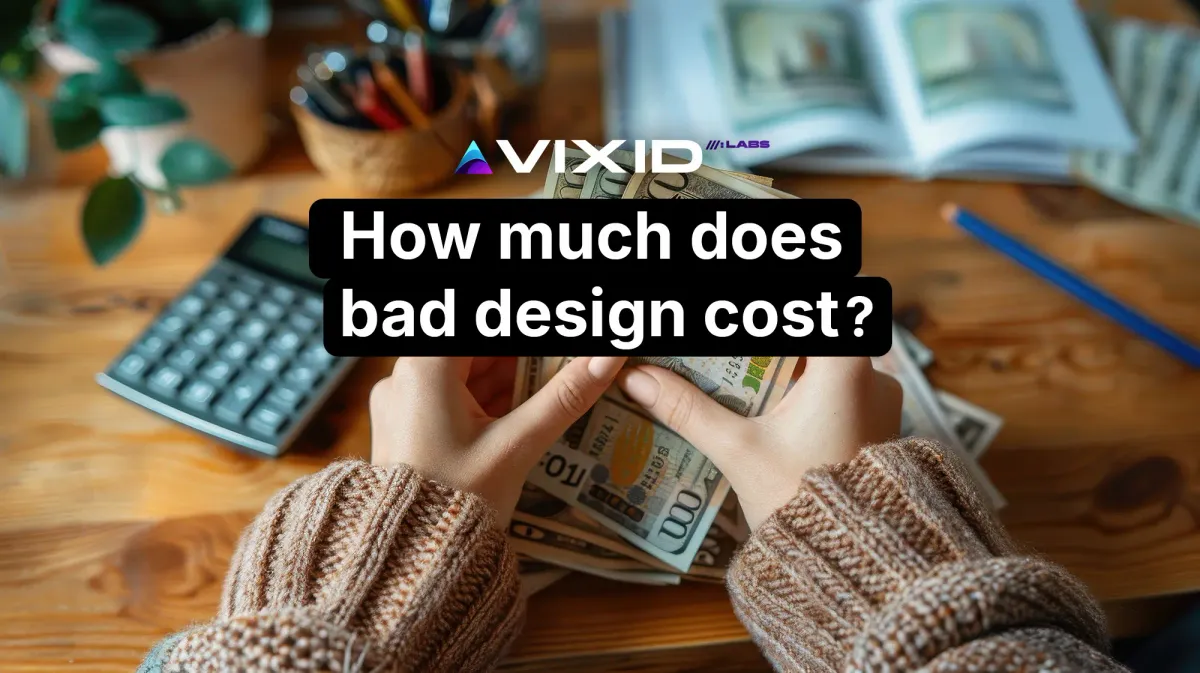Bad Design Is Expensive

If you think good design is expensive — you're right. But have you ever stopped to ask yourself: how much does bad design cost?
t’s one of those things most people notice too late — when the numbers don’t grow, when users leave, when support tickets pile up with the same complaints. At that point, design is no longer an abstract concept. It becomes very real, and very costly.
I’ve seen this happen too often — talented founders building something great on the inside, but watching it fail because the outside didn’t work. Not because it looked bad — in fact, it often looked fine. But something didn’t feel right. And that “something” was usually invisible until people tried to use it.
You see, design isn’t decoration.It’s not just how something looks. It’s how it works in the real world. That’s where I often feel we need to change the conversation entirely. When clients come to us at Vixid Labs, they usually expect us to make things “look better.” But I always tell them — if all we do is improve how it looks, we’ve failed you.
Because real design isn’t about looking good. It’s about feeling right. About removing friction. About making people think less and do more. Trust me - you don't want to lose a client just because the phone number on your business card is written on the wrong side or is too small, and the "get a consultation" button on your website doesn't work or stuck.
At Vixid Labs, design is never a blank canvas with pretty ideas. It’s a map of user behavior. It’s watching where people get stuck, what they ignore, what makes them hesitate. We test. We listen. We rebuild. And sometimes the most elegant design decision isn’t visible at all — because it’s something we quietly removed.
You know what bad design often looks like?
Nothing special. It's usually minimal. Clean. “Scandinavian,” even.
Just like that IKEA mug you’ve probably seen in every second kitchen — the one from the Färgrik series.
On the shelf it looks fine. Polished. Neutral. Feels like a good deal. Until the moment you pour yourself a hot drink and try to pick it up.
The handle barely fits a single finger. The rest of your fingers? They press directly against the mug’s surface. Which is now hot enough to make you flinch. And suddenly that relaxing tea break becomes a weird ritual of finger gymnastics and discomfort.

No one planned to make it painful. But here it is - mass-produced, in millions of homes.
And here’s the thing: that’s design too. Not the color. Not the shape. Not the brand.
The experience of using it. The feeling it leaves behind. The small pain you learn to ignore, until one day you just buy another mug. That's how bad design works. It quietly pushes people away.
Let’s talk about real consequences
Phrases like "design influences conversion" are so overused they’ve stopped meaning anything. But I've seen the numbers. I’ve seen a form with too many fields cut a checkout rate in half. I’ve seen sites lose customers just because the CTA looked like a banner ad. One client came to us wondering why nobody booked calls through their website — we opened it and found out the button wasn’t clickable on mobile. At all. Not broken. Just not wired up.
That bug cost them at least €12,000 before they even noticed. That’s what I mean when I say: bad design is expensive. And not in theory — in lost users, failed sales, broken trust.
Another time we worked with a consulting agency. Great team, solid service, polished site — or so it seemed. The issue? Their scheduling form was too big, too much usless field. On mobile it didn't fit on one screen. The lead at this point thinks - hey, what do you want from me? Here is my name, here is my number, call me or your competitor will do it! So they had a fancy header and zero leads from 70% of their audience. Small detail. Big damage.
It’s not just websites. Think packaging. A luxury skincare brand we helped last year was getting dozens of returns per month. Not because of the product — the product was excellent — but because the lid was nearly impossible to open with wet hands. Their customers were literally dropping glass bottles in the sink. Adding a tactile texture decreased returns by 80% in one month.
These aren't edge cases. This is the everyday impact of ignoring how things are actually used.
Design isn't about theory. It's not even about beauty. It's about making sure your product does what it promises — smoothly, naturally, without second thought. And when it doesn't, people won't complain. They'll just go somewhere else.
Let me give you a better example.
A few years ago, we worked on an app for young mothers — a tool to quickly find baby care tips, home remedies, feeding routines. On paper, everything worked. The visuals were clean, the navigation was standard, even beautiful. But it was broken.
Why? Because all the key actions — search, bookmarks, quick access — were placed in the top third of the screen. Try using that one-handed while cradling a crying baby in your other arm. You can’t!
No amount of visual polish can compensate for a design that ignores the physical reality of your user.
And it’s not just new mothers. Think about how you use your phone — often on the go, often one-handed, sometimes while juggling bags, food, a coffee. Now think about how many apps still put their most-used buttons out of reach. For no reason, other than following a template.
Now take it a step further.
What if your user literally only has one hand? What if their dominant hand is in a cast? What if they have a temporary or permanent disability? You think that’s rare? It’s not.
And if you ignore that, you're not just losing conversions. You’re excluding real people from using your product.
In Germany — and much of Europe — this isn’t just bad practice. It can be grounds for legal action. Discriminatory design isn’t just ethically wrong — it can cost you millions.
This is why good design starts with empathy, not Photoshop. You have to assume less. You have to look beyond your own comfort. You have to test with real people — not idealized personas. And you have to treat design not as a surface — but as an interface between life and technology.
That didn’t come from a moodboard. It came from data.
From watching real people struggle, and respecting their time. And that’s what makes design good. Not taste. Not aesthetics, but empathy, clarity and adaptability.
Every product lives in the real world. In messy, unpredictable, mobile-first, under-caffeinated, low-light conditions. People use your product when they’re distracted, tired, multitasking. If you want them to stay — your design needs to meet them there.
That’s why we invest in design early. Not to win awards — but to avoid re-building everything later. Because nothing drains a business faster than launching with something that feels off.
So, what makes design good?
Good design works. Always and for everyone. It anticipates the real situations people are in, not the perfect ones you imagine sitting on a comfortable sofa. It works when your user is tired, distracted, holding a baby, rushing to catch a train, or using their non-dominant hand. It works for someone who can see perfectly, and for someone who can’t. It works for the tech-savvy and the tech-averse.
And the only way to get there is to watch, measure, and adapt.
That’s why at Vixid Labs we don’t treat design as a “final layer” of a project. We treat it as a living system — one that evolves with the people who use it. We look at analytics, heatmaps, user feedback. We fix what’s slowing them down. We remove what’s confusing. We add only what helps.
Because a launch isn’t the end of design. It’s the beginning of its real life.
And here’s the thing: bad design is a cost you pay over and over — in lost sales, in support calls, in legal risks, in damaged reputation.
Good design is an investment you make once, and it keeps paying back.
So before you ask how much good design costs, ask yourself: Can you afford the price of bad design?





